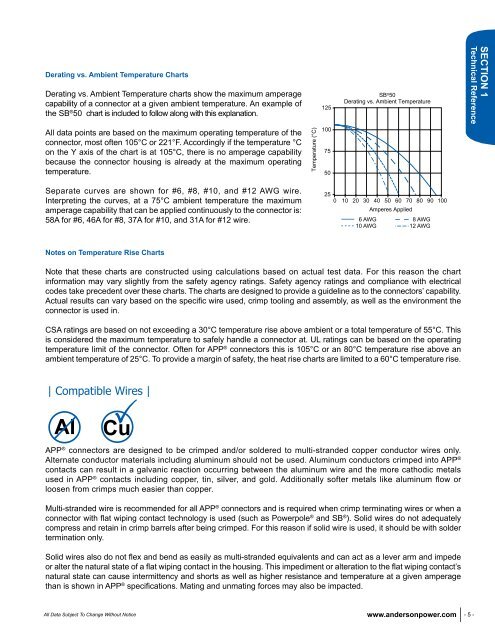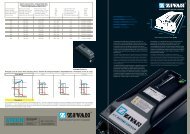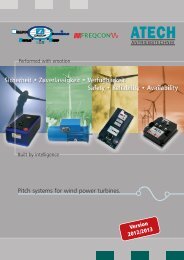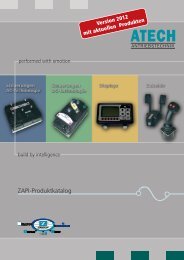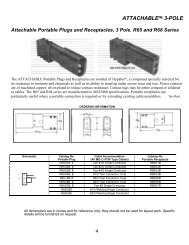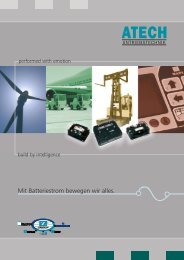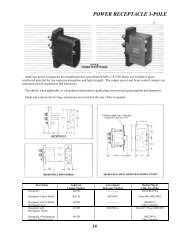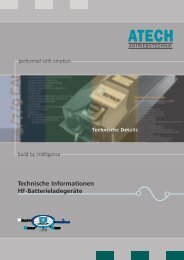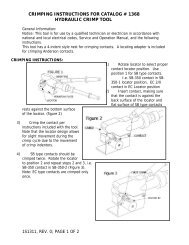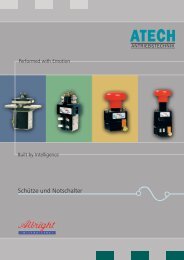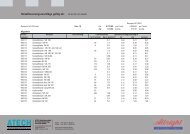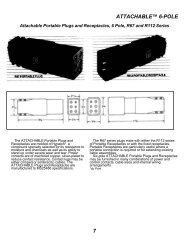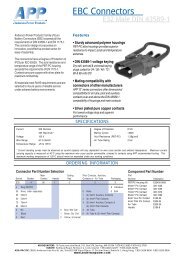Batteriestecker - Atech Antriebstechnik
Batteriestecker - Atech Antriebstechnik
Batteriestecker - Atech Antriebstechnik
Create successful ePaper yourself
Turn your PDF publications into a flip-book with our unique Google optimized e-Paper software.
Derating vs. Ambient Temperature Charts<br />
Derating vs. Ambient Temperature charts show the maximum amperage<br />
capability of a connector at a given ambient temperature. An example of<br />
the SB ® 50 chart is included to follow along with this explanation.<br />
All data points are based on the maximum operating temperature of the<br />
connector, most often 105°C or 221°F. Accordingly if the temperature °C<br />
on the Y axis of the chart is at 105°C, there is no amperage capability<br />
because the connector housing is already at the maximum operating<br />
temperature.<br />
Temperature (°C)<br />
125<br />
100<br />
75<br />
50<br />
SB ® 50<br />
Derating vs. Ambient Temperature<br />
SECTION 1<br />
Technical Reference<br />
Separate curves are shown for #6, #8, #10, and #12 AWG wire.<br />
Interpreting the curves, at a 75°C ambient temperature the maximum<br />
amperage capability that can be applied continuously to the connector is:<br />
58A for #6, 46A for #8, 37A for #10, and 31A for #12 wire.<br />
25<br />
0 10 20 30 40 50 60 70 80 90 100<br />
Amperes Applied<br />
6 AWG 8 AWG<br />
10 AWG 12 AWG<br />
Notes on Temperature Rise Charts<br />
Note that these charts are constructed using calculations based on actual test data. For this reason the chart<br />
information may vary slightly from the safety agency ratings. Safety agency ratings and compliance with electrical<br />
codes take precedent over these charts. The charts are designed to provide a guideline as to the connectors’ capability.<br />
Actual results can vary based on the specific wire used, crimp tooling and assembly, as well as the environment the<br />
connector is used in.<br />
CSA ratings are based on not exceeding a 30°C temperature rise above ambient or a total temperature of 55°C. This<br />
is considered the maximum temperature to safely handle a connector at. UL ratings can be based on the operating<br />
temperature limit of the connector. Often for APP ® connectors this is 105°C or an 80°C temperature rise above an<br />
ambient temperature of 25°C. To provide a margin of safety, the heat rise charts are limited to a 60°C temperature rise.<br />
| Compatible Wires |<br />
Al<br />
Cu<br />
APP ® connectors are designed to be crimped and/or soldered to multi-stranded copper conductor wires only.<br />
Alternate conductor materials including aluminum should not be used. Aluminum conductors crimped into APP ®<br />
contacts can result in a galvanic reaction occurring between the aluminum wire and the more cathodic metals<br />
used in APP ® contacts including copper, tin, silver, and gold. Additionally softer metals like aluminum flow or<br />
loosen from crimps much easier than copper.<br />
Multi-stranded wire is recommended for all APP ® connectors and is required when crimp terminating wires or when a<br />
connector with flat wiping contact technology is used (such as Powerpole ® and SB ® ). Solid wires do not adequately<br />
compress and retain in crimp barrels after being crimped. For this reason if solid wire is used, it should be with solder<br />
termination only.<br />
Solid wires also do not flex and bend as easily as multi-stranded equivalents and can act as a lever arm and impede<br />
or alter the natural state of a flat wiping contact in the housing. This impediment or alteration to the flat wiping contact’s<br />
natural state can cause intermittency and shorts as well as higher resistance and temperature at a given amperage<br />
than is shown in APP ® specifications. Mating and unmating forces may also be impacted.<br />
All Data Subject To Change Without Notice<br />
www.andersonpower.com - 5 -


